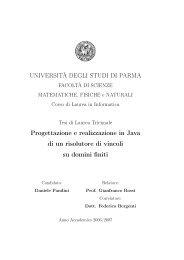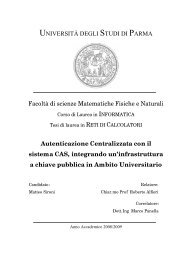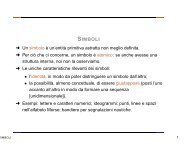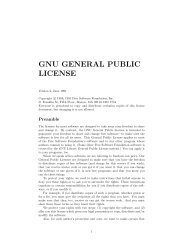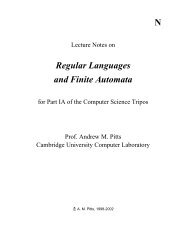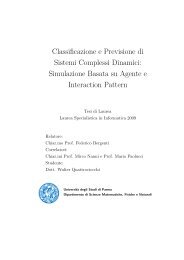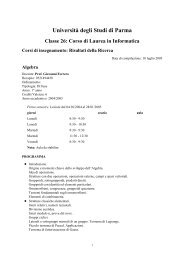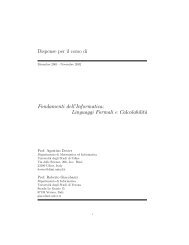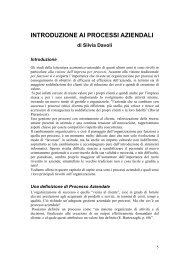a modern C++ library for the manipulation of Boolean functions
a modern C++ library for the manipulation of Boolean functions
a modern C++ library for the manipulation of Boolean functions
You also want an ePaper? Increase the reach of your titles
YUMPU automatically turns print PDFs into web optimized ePapers that Google loves.
1 <strong>Boolean</strong> <strong>functions</strong><br />
1.1 Fundamental concepts<br />
1.1.1 Definition <strong>of</strong> <strong>Boolean</strong> <strong>functions</strong><br />
<strong>Boolean</strong> <strong>functions</strong> are <strong>functions</strong> that depend on a set <strong>of</strong> <strong>Boolean</strong> variables. The variables<br />
and <strong>the</strong> function itself have <strong>the</strong>ir values in {0, 1}. We will also refer to <strong>the</strong> elements 0 and<br />
1 as false and true respectively. Formally, we denote <strong>the</strong> infinite and numerable set <strong>of</strong><br />
<strong>Boolean</strong> variables as Vars. We also define a total order relation ≺ over Vars that allows<br />
us to assign an index i ∈ N to each variable xi ∈ Vars. We can now give <strong>the</strong> <strong>for</strong>mal<br />
definition <strong>of</strong> <strong>Boolean</strong> valuation and <strong>Boolean</strong> function.<br />
Definition 1. (<strong>Boolean</strong> valuations and <strong>Boolean</strong> <strong>functions</strong>.) The set <strong>of</strong> <strong>Boolean</strong><br />
valuations over Vars is defined as A def<br />
= Vars → {0, 1}. The set <strong>of</strong> <strong>Boolean</strong> <strong>functions</strong> is<br />
defined as F def<br />
= A → {0, 1}.<br />
Sometimes we may use variable assignment as a synonym <strong>for</strong> <strong>Boolean</strong> valuation.<br />
1.1.2 Denoting specific <strong>Boolean</strong> <strong>functions</strong><br />
We will use a simple notation to refer to specific <strong>Boolean</strong> <strong>functions</strong>, exploiting <strong>the</strong> fact<br />
that <strong>the</strong>y can all be obtained by applying a few simple operators on a few elementary<br />
<strong>functions</strong>. We can start by defining <strong>the</strong> <strong>Boolean</strong> <strong>functions</strong> ⊥ and ⊤ as <strong>the</strong> <strong>Boolean</strong><br />
<strong>functions</strong> which evaluate to false and true respectively in any given <strong>Boolean</strong> valuation.<br />
For each variable x ∈ Vars, we also write x to denote <strong>the</strong> <strong>Boolean</strong> function f such that<br />
∀a ∈ A : f(a) = 1 ⇐⇒ a(x) = 1. It should always be clear whe<strong>the</strong>r we are referring to<br />
<strong>the</strong> variable or to <strong>the</strong> function in a specific context.<br />
Now we define a few basic binary operations over F. For each pair <strong>of</strong> <strong>Boolean</strong> <strong>functions</strong><br />
f1, f2 ∈ F, we write f1 ∧ f2 to denote <strong>the</strong> <strong>Boolean</strong> function g ∈ F such that <strong>for</strong> each<br />
a ∈ A, g(a) = 1 ⇐⇒ (f1(a) = 1 ∧ f2(a) = 1). We define all o<strong>the</strong>r common operations<br />
analogously; here is a complete list:<br />
Definition 2. (Binary operators on <strong>Boolean</strong> <strong>functions</strong>.) ∀f1, f2 ∈ F :<br />
f1 ∧ f2 def<br />
= g ∈ F . ∀a ∈ A : g(a) = 1 ⇐⇒ f1(a) = 1 ∧ f2(a) = 1 ,<br />
f1 ∨ f2 def<br />
= g ∈ F . ∀a ∈ A : g(a) = 1 ⇐⇒ f1(a) = 1 ∨ f2(a) = 1 ,<br />
f1 ⊕ f2 def<br />
= g ∈ F . ∀a ∈ A : g(a) = 1 ⇐⇒ f1(a) = f2(a) ,<br />
f1 ⇔ f2 def<br />
= g ∈ F . ∀a ∈ A : g(a) = 1 ⇐⇒ f1(a) = f2(a) ,<br />
f1 ⇒ f2 def<br />
= g ∈ F . ∀a ∈ A : g(a) = 1 ⇐⇒ f1(a) = 0 ∨ (f1(a) = 1 ∧ f2(a) = 1) .



